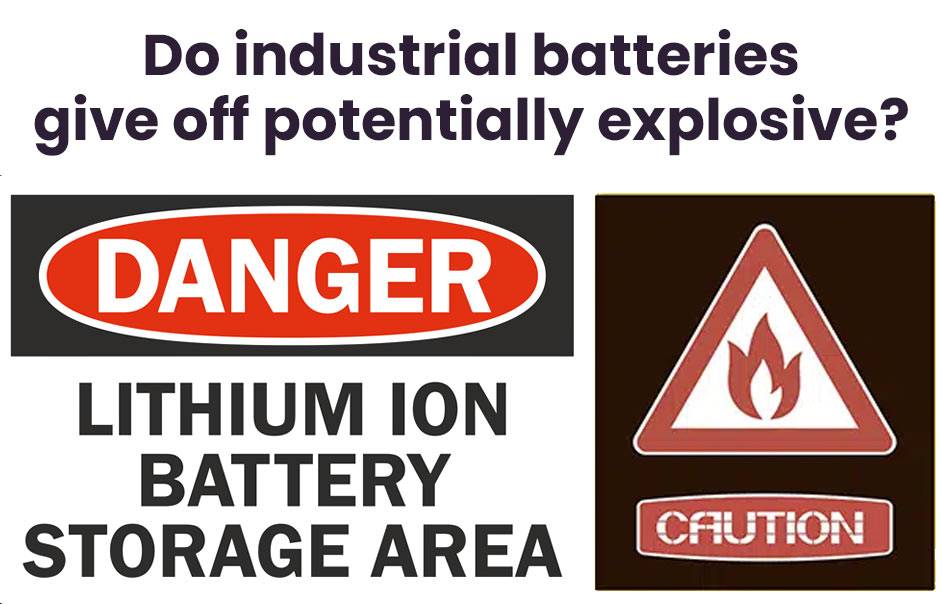- Forklift Lithium Battery
- Golf Cart Lithium Battery
- Rack-mounted Lithium Battery
51.2V 100Ah Rackmount LiFePO4 Battery
8000 times (80% DOD 0.5C)
Optional SNMP for TELECOM - Car Starter Battery
- 12V LiFePO4 Battery
12V 150Ah Lithium RV Battery
Bluetooth App | Self-heating
LiFePO4 | Group 31
UL 1642 | IEC 62619 - 24V LiFePO4 Battery
- 36V LiFePO4 Battery
- 48V LiFePO4 Battery
- 60V LiFePO4 Battery
60V 100Ah Lithium Battery (AGV, AMR, LGV)
Peak Discharge Current 400A
500 x 298 x 349 mm - 72V~96V LiFePO4 Battery
72V 100Ah Lithium Golf Cart Battery
Peak Discharge Current 315A (10S)
740 × 320 × 246 mm - Wall-mounted Lithium Battery
51.2V 100Ah 5kWh
Wall-mounted Battery532 x 425 x 170 mm / LiFePO4
>8000 Cycles (80% DOD 0.5C)
RS485 / CAN-bus
for Solar Home ESS - Home-ESS All-in-One
51.2V 32kWh
All-in-On HESS SystemPowerAll
51.2V / LiFePO4
>8000 Cycles (80% DOD 0.5C)
RS485 / CAN-bus / WiFi
All-in-One for Home ESS
Do Industrial Batteries Pose a Risk of Explosion?

Industrial batteries, particularly lithium-ion types, can pose explosion risks under certain conditions, such as overcharging, physical damage, or improper handling. Understanding these risks is crucial for ensuring safety in environments where industrial batteries are used.
What Are the Risks of Explosion Associated with Industrial Batteries?
Industrial batteries can indeed be hazardous, with potential risks of explosion stemming from various factors. While lead-acid batteries generally present lower risks, lithium-ion batteries are more susceptible to thermal runaway—a chain reaction that can lead to overheating and explosions. Proper safety protocols are essential to mitigate these risks.Chart: Comparison of Explosion Risks by Battery Type
| Battery Type | Explosion Risk Level | Common Causes of Explosion |
|---|---|---|
| Lead-Acid | Low | Overcharging, physical damage |
| Lithium-Ion | High | Overcharging, thermal runaway, damage |
| Nickel-Cadmium (Ni-Cd) | Moderate | Overcharging, physical damage |
| Nickel-Metal Hydride (Ni-MH) | Moderate | Improper handling, overcharging |
How Do Factors Like Overcharging and Physical Damage Contribute to Explosions?
Several key factors can lead to battery explosions:
- Overcharging: Exceeding the recommended charge limit generates excess heat and pressure within the battery, potentially leading to thermal runaway.
- Physical Damage: Punctures or leaks can disrupt the internal chemistry, causing volatile reactions that increase explosion risks.
- Environmental Conditions: Extreme temperatures can accelerate chemical reactions within batteries, heightening instability.
Chart: Common Causes of Battery Explosions
| Cause | Description |
|---|---|
| Overcharging | Excessive heat buildup from improper charging |
| Physical Damage | Cracks or punctures exposing internal components |
| Poor Maintenance | Neglecting regular inspections leading to failures |
| Environmental Factors | High temperatures or exposure to flammable materials |
Which Types of Industrial Batteries Are Most Likely to Explode?
Among industrial batteries, lithium-ion batteries present the highest explosion risk due to their high energy density and chemical composition. Other types include:
- Lead-Acid Batteries: Generally safer but still hazardous if mishandled.
- Nickel-Cadmium (Ni-Cd) Batteries: Moderate risk; less common today.
- Nickel-Metal Hydride (Ni-MH) Batteries: Safer than Ni-Cd but still require careful handling.
What Safety Measures Can Be Implemented to Prevent Battery Explosions?
To minimize the risk of battery explosions, implement the following safety measures:
- Proper Training: Ensure all personnel are trained in safe handling and emergency procedures.
- Regular Inspections: Conduct routine checks on battery conditions and charging equipment.
- Ventilation: Maintain adequate ventilation in storage areas to disperse any gases produced.
- Avoid Flammable Materials: Keep batteries away from sparks, flames, and other ignition sources.
How Can Proper Handling and Maintenance Reduce Explosion Risks?
Proper handling and maintenance practices significantly reduce the likelihood of battery-related incidents:
- Use Protective Equipment: Workers should wear gloves and goggles when handling batteries.
- Follow Charging Protocols: Only use chargers specified for the battery type and avoid overcharging.
- Store Safely: Keep batteries in cool, dry places away from direct sunlight or heat sources.
Chart: Best Practices for Battery Handling
| Practice | Description |
|---|---|
| Use PPE | Wear appropriate protective gear |
| Follow Charging Protocols | Adhere strictly to manufacturer guidelines |
| Regular Maintenance | Schedule inspections and maintenance checks |
Tips for Battery Wholesale Buyers: How to Choose a Reliable Manufacturer?
When considering wholesale purchases or OEM orders for batteries, it’s crucial to choose a reliable manufacturer. Here are some tips:
- Research Manufacturer Reputation: Look for established companies like Redway Power, known for quality and reliability.
- Evaluate Product Range: Ensure they offer various battery types suitable for your needs.
- Check Certifications: Confirm compliance with industry standards.
For OEM orders from a reputable manufacturer like Redway Power, which has over 13 years of experience in lithium battery manufacturing, ensure clear communication regarding specifications and delivery timelines. This approach helps secure high-quality products that serve as excellent alternatives to lead-acid batteries.
Redway Power Expert Views
“Understanding the risks associated with industrial batteries is vital for ensuring workplace safety. By implementing proper handling procedures and regular maintenance checks, businesses can significantly reduce the likelihood of accidents,” states an expert from Redway Power.
FAQ Section
- Do industrial batteries pose explosion risks?
Yes, particularly lithium-ion batteries which can explode due to overcharging or physical damage. - What causes battery explosions?
Common causes include overcharging, physical damage, poor maintenance, and extreme environmental conditions. - How can I prevent battery explosions?
Implement safety measures such as proper training, regular inspections, adequate ventilation, and avoiding flammable materials.


















